|
|
|
|
Products mentioned in this Article
--None--
|
|
|
|
|
|
|
|
|
 |
|
|
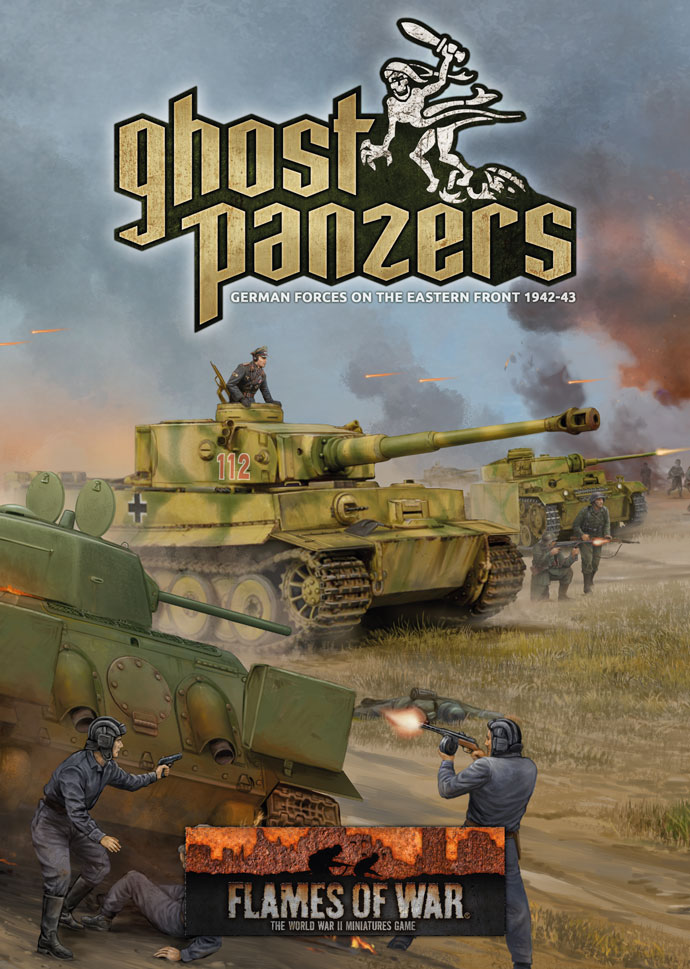 |
The German counter-attack during
the Third Battle Of Kharkov
The 1st Phase Third Battle of Kharkov…
While sometimes referred to as a seperate battle, it was in reality the same struggle continued against the on going Soviet offensive drive towards to the Dnieper River. The Germans still had a massive 110-mile hole in their lines and the gap needed to be closed.
Hitler himself flew to the frontline headquarters of Manstein (at Zaporozhye, just 36 miles from advancing Soviet forces) on February 17 where he was informed of the situation.
Manstein convinced Hitler the immediate priority was not the recapture of Kharkov, but rather to bring a halt of the Soviet breakthrough to the south of the city.
|
|
Armee-Abteilung (Army Detachment) Kempf positioned to the west of Kharkov was in danger of being cut off from the rest of Heersgruppe Sud (Army Group South). The threat came from the Soviet 3rd Tank, 1st Guards Armies and Mobile Group Popov driving south west through the gap towards the Dnieper.
Manstein plan was to send Hoth’s 4. Panzerarmee, recently withdrawn from the Caucasus, north towards Armee-Abteilung Kempf’s positions with the aim of halting the two Soviet Armies advancing through the gap towards Dnepropetrovsk (3rd Tank and 1st Guards Armies).
|
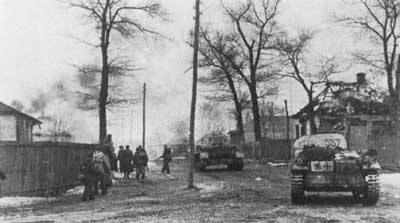 |
| At Hoth’s disposal was Hausser’s SS Panzerkorps consisting of SS Panzergrenadier divisions Das Reich and Totenkopf (SS Leibstandarte remained under the command of Armee-Abteilung Kempf). Panzerkorps XLVIII was also assigned to the Hoth’s Panzer army, it included the 6. and 17. Panzer Divisions.
While Hoth halted the drive on Dnepropetrovsk, von Mackensen’s 1. Panzerarmee would attack Mobile Group Popov to their immediate north.
The offensive began on February 19, with the SS Das Reich driving south from their positions around Poltava taking Novo-Moskovsk on the Samara River on February 20. It then advanced on Pavlograd on the following day threatening the flank of the Soviets. These manoeuvres cut off the Soviet thrust trapping substantial numbers of Soviet troops south of the Samara. From February 22-23, the division destroyed more units while driving the remainder north before them across the Samara.
|
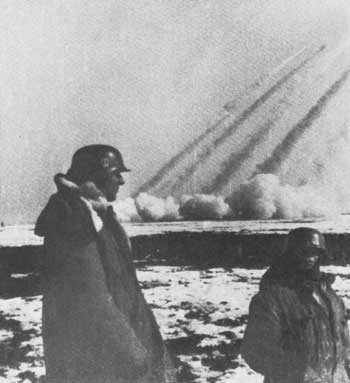 |
During this SS Totenkopf (freshly arrived at the front) followed SS Das Reich on a parallel course to the left, but staying north of the Samara. Both divisions turned east on February 23.
By February 24 they were joined by the 6. and 17. Panzer Divisions of XLVIII Panzerkorps, they all moved northwards cutting off the supply line of the Soviets armies and crushing any Soviet units in their path.
Meanwhile 1. Panzerarmee had attacked Mobile Group Popov, leading the way were the units of the XL Panzerkorps (7. and 11. Panzerdivisions, and SS Wiking Panzergrenadier division and the 333. Infantry Division). The trapped a large number of Popov’s units around Krasnoarmeyakoye in pincer move, destroying many units. Some of Popov’s more mobile troops were able to escape north to Barvenkoyo.
The initial offensive was a complete success, the Soviet advance had been stopped and they were in disarray. Manstein was pleased and now looked towards the next phase of his operation. On February 25 Manstein sent his two Panzerarmees north in preparation of an attack against the Voronezh front facing Kharkov.
|
|
1. Panzerarmee was to take Petrovskoye and Izyum and the 4. Panzerarmee was to advance on Lozovaya to the northeast. The 1. Panzerarmee was to cut off the Soviets escape routes across the Donetz River while the 4. Panzerarmee was position itself to advance along the railway towards Kharkov.
The Soviet forces facing them were now low on fuel and other supplies, though infantry units held on tenaciously in some sectors. SS Das Reich took Lozovaya on February 26, but only after intensive street fighting. Two days late 17. Panzerdivision took Petrovskoye. Low on fuel the remnants of Mobile Group Popov and units of the 1st Guards Army were forced to make a stand against the 1. Panzerarmee near Barvenkoyo, the Soviets were crushed.
|
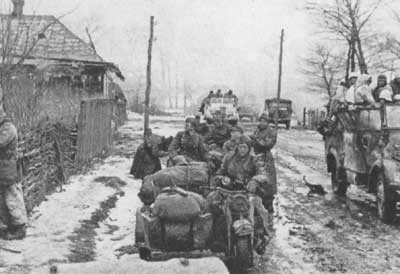 |
|
Time was now the German’s most pressing enemy, the Spring thaw was approaching and once it hit the roads would quickly turn to mud, making rapid movement difficult.
Manstein ordered Hoth’s 4. Panzerarmee to advance on Kharkov and von Mackensen’s 1. Panzerarmee to advance east of Petrovskoye on the Donetz River. The next phase of the offensive started on March 1, both armies made amazing progress in spite of the thaw, the 4. Panzerarmee made 50 mile in just five day to be within ten mile of Kharkov on March 5. Little serious resistance was meet until the SS Panzerkorps ran into units of the Soviet 3rd Tank Army sent to counter-attack the advancing Germans. The SS Panzerkorps (now including SS Leibstandarte who rejoined with them on March 4) soon surrounded three rifle and three tank brigades.
|
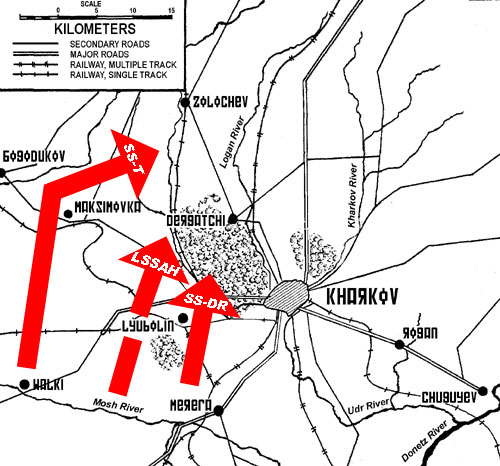 |
On March 5 SS Totenkopf finished off the pocket. On March 6 SS Lebstandarte gained a bridgehead over the Mosh River at Bridok, opening the way to Kharkov.
To the East the 1. Panzerarmee had secured most of the Donetz, leaving the Soviet only a few places from which to escape.
Hoth and Manstein were undecided whether to push on to Kharkov; the Spring thaw was still a factor. The weather intervened with a cold snap on March 7, hardening up the ground again and allowing for faster movement. The offensive was on again.
The plan now called for 4. Panzerarmee to swing west around Kharkov to make contact with Armee-Abteilung Kempf.
|
|
The SS Panzerkorps was to cut Soviet communications from the west of Kharkov before swinging north to encircle the city.
The SS Panzerkorps advanced on a broad frontage between Walki to the west and Merefa to the east; they made good speed and were joined by Grossdeutschland (from Armee-Abteilung Kempf) to their left. By March 9 they had reached the western outskirts of Kharkov. Three Soviet armies stood in their way, Kazakov’s 69th to the north of Kharkov; Moskalenko’s 40th to the south and Rybalko’s 3rd Tank Army defending the city itself. At Rybalko’s disposal inside Kharkov were the 1st and 2nd Guards Tank Corps and the 48th, 104th, 305th and 307th Rifle Divisions.
Despite Hoth’s orders to stay outside the city the SS Panzerkorps was drawn in, motivated by their desire to avenge their defeat and retreat from the city mere weeks before. Hausser took advantage of ambiguous orders to take the city only if an easy opportunity arrived to take the city at speed. He made plans to take the city on March 9 and ordered were issued to start the assault on the morning of March 10.
The Fighting For Kharkov
|
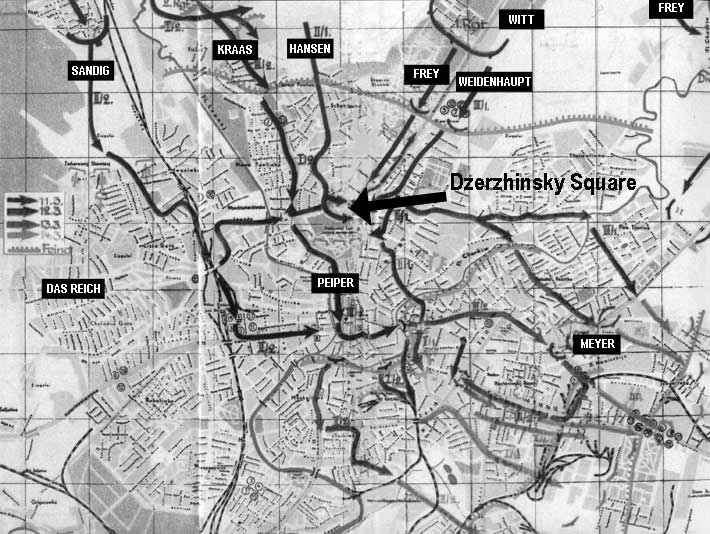 |
|
Traffic and Soviet resistance delayed Hausser’s plans a further day. Leibstandarte spent most of March 10 fighting its way through Dergatchi, a town to the northwest of Kharkov.
SS Das Reich was to attack from the west, SS Leibstandarte from the north, and SS Totenkopf was to screen the Northwest. Kampfgruppes were form and each was given a road to attack down.
|
|
Right: Kampfgruppe Witt on the Belgorod road running into kharkov the day before they launch their assault March 11.
The Kampfgruppes were:
SS Leibstandarte
Under SS-Standartenführer Georg Wisch (2nd SS Panzergrenadier Regiment)
Kampfgruppe Kraas: Commander SS-Sturmbannführer Hugo Kraas
I. Battalion 2nd SS Panzergrenadier Regiment
StuG Platoon (4 StuG III F/8)
FlaK Platoon (3 Sd Kfz 7/2)
|
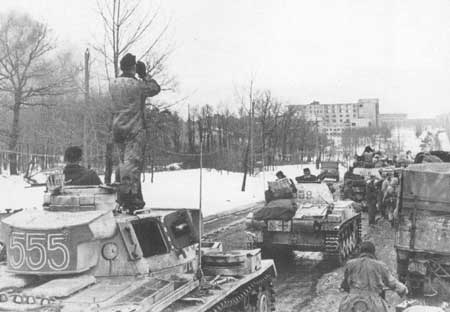 |
|
Kampfgruppe Sandig: Commander SS-Sturmbannführer Rudolf Sandig
II. Battalion 2nd SS Panzergrenadier Regiment
Kampfgruppe Hansen: Commander SS-Sturmbannführer Max Hansen
III. Battalion 2nd SS Panzergrenadier Regiment
Under SS-Standartenfuhrer Fritz Witt (1st SS Panzergrenadier Regiment)
Kampfgruppe Witt (two columns under Frey and Weidenhaupt)
I. II. and III. Battalions 1st SS Panzergrenadier Regiment
II. Abteilung SS-Panzer Regiment 1 (SS-Sturmbannführer Martin Gross)
Under SS-Sturmbannführer Kurt Meyer
Kampfgruppe Meyer
Aufklarungsabteilung (Divisional Reconnaissance Battalion)(Meyer)
I. Abteilung SS-Panzer Regiment 1 (SS-Sturmbannführer Max Wünsche)
SS Das Reich
Kampfgruppe Harmel: (SS-Obersturmbannführer Heinz Harmel)
I. and III. Battalions SS-Panzergrenadier Regiment "Deutschland"
III. Battalion SS-Panzergrenadier Regiment "Der Führer"
SS Pioneer Battalion 2
SS Artillery Regiment 2 (less on battery)
SS FlaK Abteilung 2
1 battery of SS Sturmgeschutz Abteilung 2
SS Panzer Regiment 2 (Only a few tanks still running)
1. Kompanie Panzer Abteilung Totenkopf (on loan from SS Totenkopf Division)
|
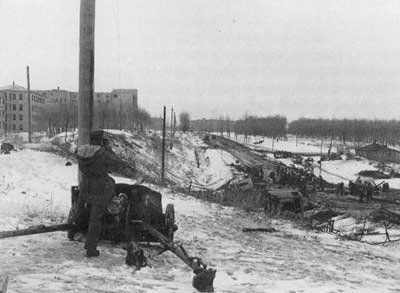 |
At 0400 hours on the morning of March 11 SS Leibstandarte commander Sepp Dietrich sent attacks down four separate roads into Kharkov. Wisch’s two Kampfgruppes advanced on either side of the Belgorod-Kharkov railway line running into the city from the north. By 0530 Kampfgruppe Sandig had advanced down the western side of the railway along the Dergatchi-Kharkov road as far a Severnyi Post.
Sandig soon ran into stiff resistance from Soviet troops entrenched in higher ground to the west, they advanced slowly from one strong point to another. By the end of the day they had only got as far as the Severnyi railway yards.
Kamfgruppe Kraas meanwhile advanced up the other side of the railway. At 0310 they stormed the suburb of Alexayevka.
|
|
The Soviets fought back throwing one company out while counter-attacking with T-34s. By the early afternoon Stukas were called in to clear the way, supported by fire from the Kampfgruppes StuG platoon.
The Panzergrenadiers made slow progress, battling their way forward against fierce opposition. A T-34 knocked out one of the StuGs and some concealed anti-tanks guns claimed one of the Kampfgruppe’s Sd Kfz 7/2. The Panzergrenadiers finally penetrated the outer city when a group out flanked the Soviet forward positions from the west and attacked their rear.
Witt’s forces (Kampfgruppe Witt with two columns under Frey and Weidenhaupt) advanced from the north down the Belgorod-Kharkov road. Before even entering the city they ran into a Soviet counter-attack from across Kharkov airfield. They bet off the attack, knocking out several T-34s in the process and had entered the city by 0750. During the afternoon Kampfgruppe Witt reached the inner suburbs of Kharkov.
|
|
Kamfgruppe Meyer approached the city from the northeast along the road from Zirkuny. Their objective was to secure the city’s eastern approaches, namely the road to Rogan and Chuguyev. They quickly ran into opposition and lost their lead Panzer and Meyer’s command half-track they quickly pushed on into the Imeni Kirova suburb. There they dug-in as they were running low on fuel. They faced numerous attacks from Soviet units trying to force their way east.
On the western side of Kharkov Das Reich had also joined the attack and at 0800 left Sinolisovska along the Poltava road headed for Kharkov.
|
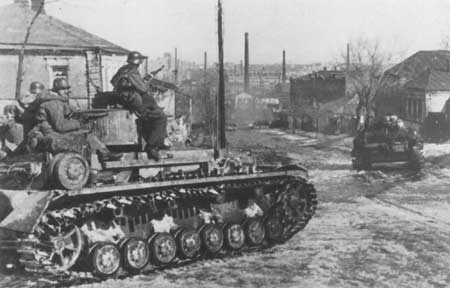 |
|
Kampfgruppe Harmel had to fight its way all the way along the road, but by 1600 they had reached the Kharkov suburb of Zalyutino. At Zalyutino they found themselves stopped by a deep anti-tank ditch, covered by anti-tank guns and artillery. The remainder of Das Reich was fighting to the south of Kharkov and had cut the Soviets off from the Merefa road.
During the day Hausser received orders from Hoth to break off Das Reich from the attack on Kharkov and to send the division around to the northeast of the city as per the original orders. Hausser argued that the risk to Das Reich was too great to break off mid battle and delays on the roads in the heavily forested areas to the north of the city too long. Instead he would send a detachment from Totenkopf to cover the northeast.
During the night of March 11/12 Kampfgruppe Harmel sent a detachment of Pioneers across the anti-tank ditch to secure the houses on the other side. The surprised the defenders and by 0440 they had captured all the anti-tank guns covering the ditch and secured a crossing point. By 0525 the Kampfgruppe was on the move again, heading towards the centre of Kharkov, late morning saw them in sight of Kharkov’s main railway station.
|
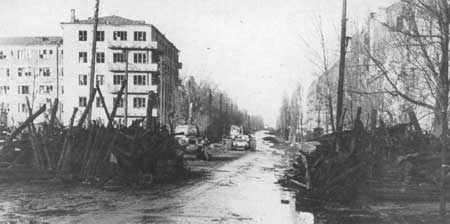 |
Hoth was not happy with Hausser’s excuses and ordered Das Reich north, this time Hausser obeyed. Hausser’s delay in had paid off to some extent, Das Reich was now able to cut through the city on good roads over less distance by moving through the areas controlled by Leibstandarte. Taking control of the city was now up to the men of Leibstandarte.
Left: A knocked out T-34 and KV seen behind barricades set-up to block access down the street.
|
|
March 12
On March 12 Leibstandarte continued their advance into the city, Kampfgruppe Sandig broke through the defensive line on the outskirts of the city during the morning, reaching the northern end of the main railway yards by 1015. By the evening the Kampfgruppe had captured the railway station itself.
Kampfgruppe Kraas continued its attack on Alexayevka, smashing the Soviets with artillery and rockets. The Soviets started to retreat and the Kampfgruppe was soon on their tails. The pursuit degenerated in to house-to-house close quarters combat in the Lisaya Gora and Pavlovka city suburbs. The Panzergrenadiers emerge on top.
Both Kampfgruppes prepared defensive positions along Katerinolavska Street.
|
|
In the north Kampfgruppe Witt’s force broke into smaller company sized groups, each supported by a few Panzers. I. and III. Battalions of SS-Panzergrenadier Regiment 1 fought from apartment building to apartment building, by nightfall they were just two blocks north of Dzerzhinsky Square in the centre of the city.
In the meantime II. Battalion under SS-Sturmbannführer Max Hansen on the western wing of Kampfgruppe Witt had penetrated the Soviets lines and had reached the western end of Dzerzhinsky Square.
|
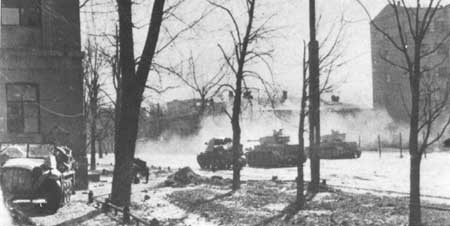 |
|
Hansen split his force in two and sent each half around one side of the square to envelope it. By evening, despite casualties from snipers positioned in the Gosprom complex, his battalion had secured the perimeter of the square. He had also linked up with the rest of Kampfgruppe Witt in Sumy Street at the eastern end of the square.
In the meantime II. Battalion under SS-Sturmbannführer Max Hansen on the western wing of Kampfgruppe Witt had penetrated the Soviets lines and had reached the western end of Dzerzhinsky Square. Hansen split his force in two and sent each half around one side of the square to envelope it. By evening, despite casualties from snipers positioned in the Gosprom complex, his battalion had secured the perimeter of the square. He had also linked up with the rest of Kampfgruppe Witt in Sumy Street at the eastern end of the square.
|
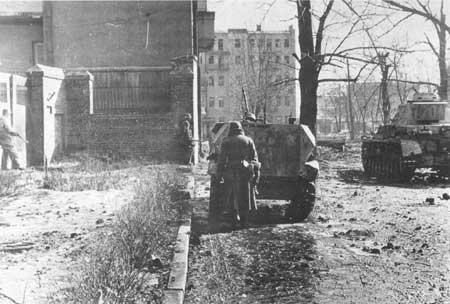 |
At 1030 III. Battalion of the SS-Panzergrenadier Regiment 2 under the command of SS-Sturmbannführer Jochen Peiper linked up with Hansen around Dzerzhinsky Square. Peiper’s unit was the armoured battalion of the regiment. Peiper’s battalion then continued another mile southeast to take a bridge across the Kharkov River leading to Moscow Avenue.
Kampfgruppe Meyer had meanwhile finally achieved its objective of securing the Volshansk and Chuguyev roads at the eastern end of the city. Set up in defensive positions around the road junction they fought of many Soviet counter-attacks throughout the day cut of from the rest of the division.
|
|
March 13
The following day Kampfgruppe Witt push on from its positions around Dzerzhinsky Square on towards the Kharkov River. Weidenhaupt’s battalion push east while Hansen headed south to link up with Peiper’s bridgehead on Moscow Avenue. Soviet resistance had firmed up and Witt’s force found it hard going. Machine-guns and anti-tank gun were everywhere and in every lane and courtyard a tank lay in wait. Each blocks had to be cleared building by building and artillery sweep the bridges and approaches.
|
|
Frey’s battalion moved from its positions near the Kharkov airfield and advanced around the outskirts of the city crossing the Kharkov River just to the north of the city. They then advance back into the city down the Volshansk road with hope of halting the Soviet escape from the city centre.
Pieper’s force had managed to enlarge their bridgehead by 1230 and had made a break down Moscow Avenue. By 1300 they had made contact with Kampfgruppe Meyer at the Volshansk/Chuguyev crossroads. Meyer’s force was now able to join the sweep through the city.
|
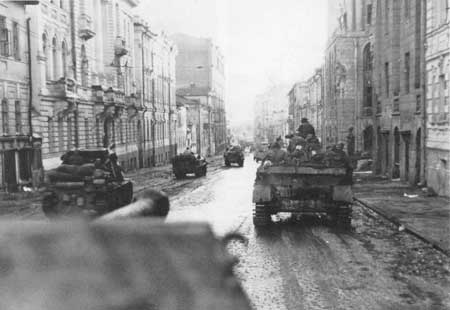 |
|
Kampfgruppe Kraas crossed over Pieper’s bridgehead and push on down Michailovsk Street while Sandig established his own bridgehead at Torgovchi Street.
By late afternoon all of Das Reich had left Kharkov for the north except SS-Sturmbannführer Bissinger’s II. Battalion of SS-Panzergrenadier Regiment "Deutschland" which continued to sweep through the southwest of the city encountering very little resistance.
|
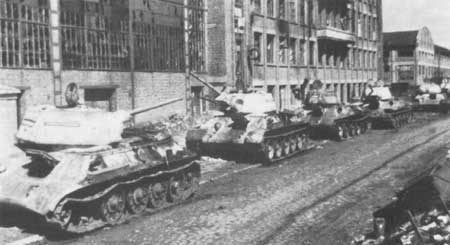 |
March 14
Fierce house-to-house and street fighting marked the final day of battle for the city of Kharkov. Kampfgruppe Witt cleared the north of the Chuguyev road, Wisch’s force down the south side and Meyer advanced down the road itself. By the evening they had established control over the city of Kharkov.
|
| There was still much mopping up to do and the German offensive ran on, March 15 saw fighting in the factory district to the southeast of the city and Kampfgruppe Kumm of Das Reich also assaulted the massive tractor factory complex from the south, tit wasn’t cleared of resistance until March 16.
XLVIII Panzerkorps swept around Kharkov from the south and were soon joined by Kampfgruppe Harmel as they cut of the Soviet 3rd Tank Army’s routes of escape across the Donetz.
|
|
On March 18 the SS Panzerkorps attacked along the Kharkov-Belgorod railway and took a mere 4 hours to take Belgorod from the Soviet 69th Army. Soviet resistance had collapsed, the Armies of the Voronezh front withdrew to hastily prepared defences on the eastern bank of the Donetz River.
The Third Battle of Kharkov was over.
Next we look at gaming options...
References
After the Battle Magazine No. 112
Time-Life World War II "The Soviet Juggernaut"
|
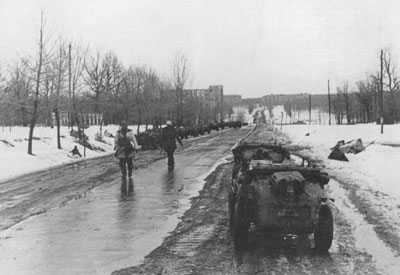 |
Last Updated On Friday, December 24, 2021 by Wayne at Battlefront
|
|
|